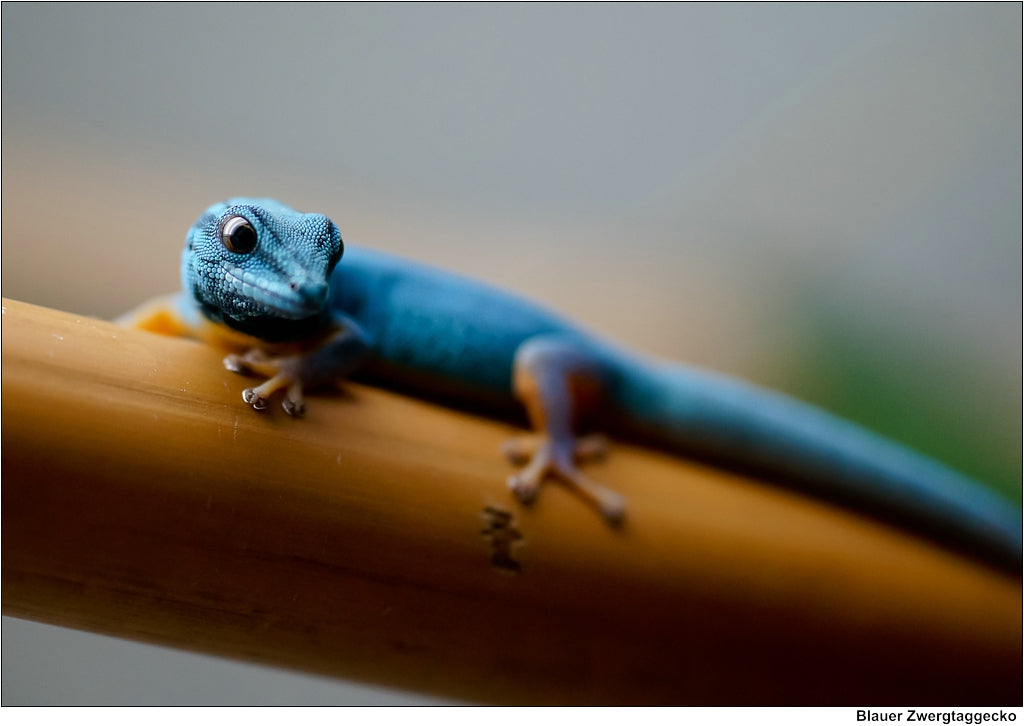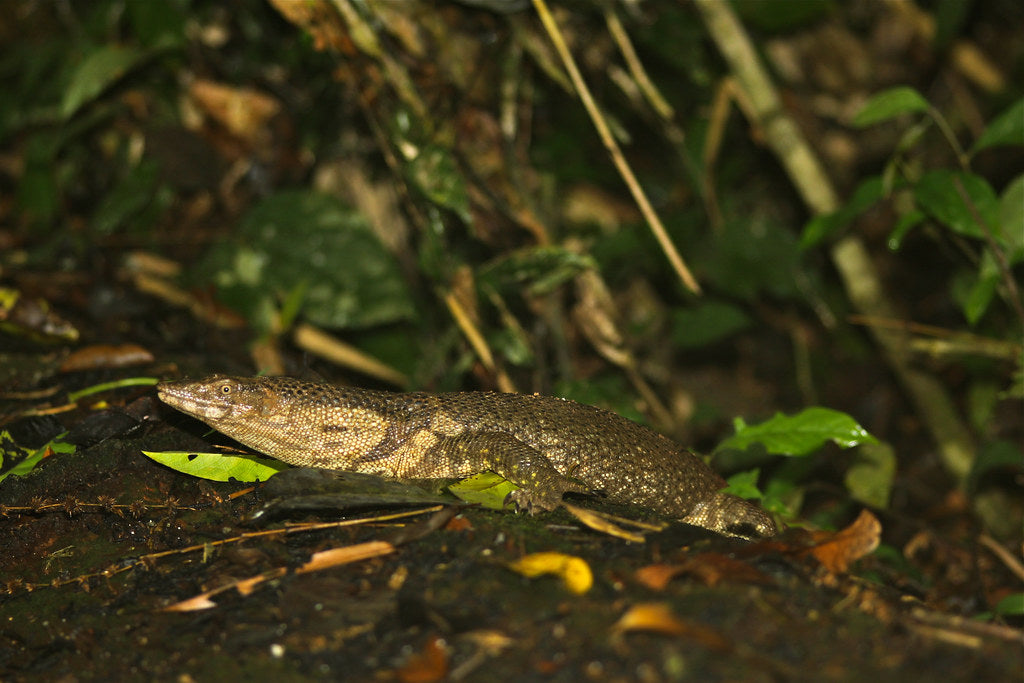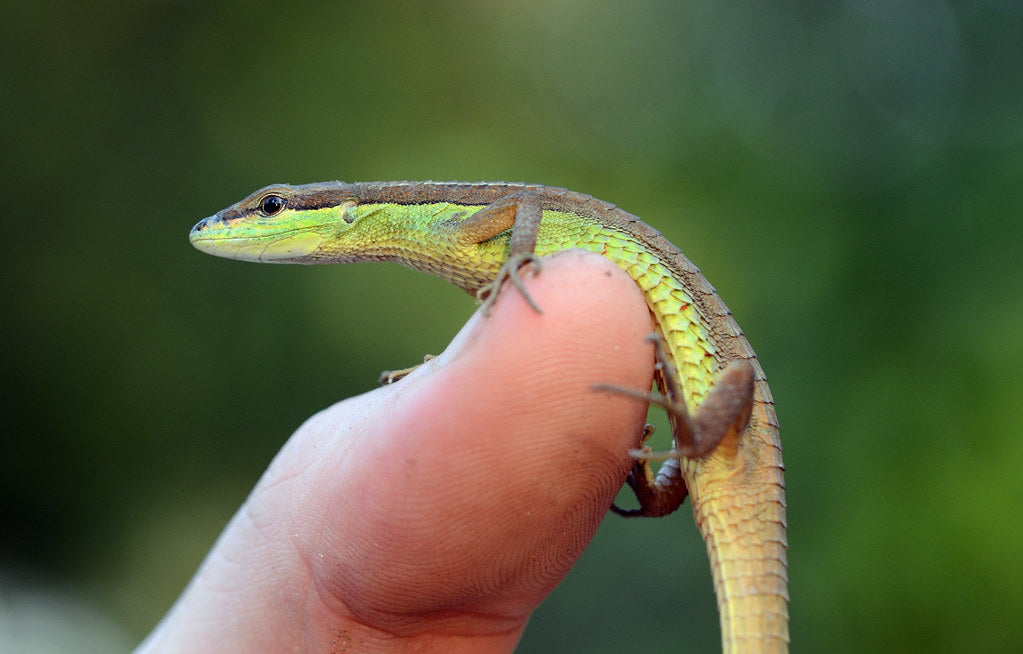Electric blue geckos (Lygodactylus williamsi) are very small, diurnal, arboreal lizards native to a limited area within Tanzania. Their habitat is exclusive to tropical forests and one species of Pandanus palm tree, and they are critically endangered in the wild due to this extreme specialization.
Electric blue geckos are typically 2.5-3.5” long, with males being slightly larger than females. They have a plump body with a sharply tapered head, large feet, rounded toes, and plump tapered tails. As can be inferred from their common name, dominant males of this species are a vivid blue color with orange bellies and feet, as well as a black throat. Females and submissive males are generally greenish orange, although some have some blue color as well. Both sexes have black striping on the head.
Because of their size and husbandry requirements, electric blue geckos are intermediate-level pet reptiles. When kept correctly, they make wonderful display animals.
How much space do electric blue geckos need?
Electric blue geckos are active, arboreal lizards who need plenty of space for running around and climbing. Fortunately, this is fairly easy to provide, given their tiny size. A single electric blue gecko should be housed in absolutely no smaller than a 12” x 12” x 18” terrarium. Of course, larger is always better!
Because this species is so small and fast, they can be amazing escape artists! Take special care to seal any gaps and cracks in the enclosure to secure it against potential escape, and make sure they can’t wedge themselves behind any decorative backgrounds.
Cohabitation (keeping multiple electric blue geckos together) is not recommended unless you plan to breed them.
Do electric blue geckos need UVB?
Yes!
Electric blue geckos need medium-strength UVB as part of their enclosure. The best UVB bulbs for electric blue geckos are:
- Zoo Med T8 Reptisun 10.0 — 4” above basking branch
- Arcadia ShadeDweller Kit — 6” above basking branch
- Arcadia T5 HO 6% — 8” above basking branch
The UVB bulb should be the full length of the enclosure, housed in a reflective fixture, and placed close to the heat lamp. UVB is blocked by glass and plastic, so you can’t give your gecko UVB by placing its terrarium in front of an open window. Also make sure that the fixture your UVB bulb is in does not have a clear plastic bulb cover.
As day-active lizards, electric blue geckos also benefit from a 6500K LED or T5 HO fluorescent grow light to provide extra bright light in the enclosure and better simulate the effects of the sun. These geckos are sun-lovers, and providing extra light is one of the best ways to enhance their color and general health.
Lights should be on for 12 hours/day to provide a natural day/night cycle.
What basking temperatures do electric blue geckos need?
Electric blue geckos should have a basking surface temperature of 90-95°F, as measured by a digital probe thermometer with the probe zip-tied to the basking surface. The general temperature in the rest of the enclosure should be maintained between 75-80°F. Nighttime temps should not drop below 65°F.
Provide heat for your gecko by imitating the sun with a halogen heat lamp placed on one side of the enclosure. Do not use a CHE or colored bulbs, as these are not as effective.
What humidity levels do electric blue geckos need?
Electric blue geckos need a moderately high humidity environment for best health. Average humidity should be between 60-80%, as measured by a digital probe hygrometer with the probe in the middle of the terrarium. However, moisture levels should be allowed to drop to around 50% during the day to discourage bacterial growth.
Misting your gecko’s enclosure with a sprayer first thing in the morning and again at night will help create the right humidity levels. It also provides an important source of drinking water! If you need help maintaining humidity, using a cool mist humidifier connected to a humidistat at night can help.
What substrate is good for electric blue geckos?
Substrate covers the floor of your gecko’s terrarium and helps make the enclosure more attractive, but it also helps maintain humidity. It’s ideal to use a substrate that imitates the “substrate” that the reptile naturally lives on in the wild. For electric blue geckos, that means it should resemble tropical soil. It should have small particles and hold moisture well.
We recommend the following substrates for electric blue geckos:
Layering clean, chemical-free leaf litter on top of the substrate can also help with humidity.
Substrate should be at least 2” deep and completely replaced every 3-4 months. Remove poop and urates daily, along with contaminated substrate. Bioactive setups can be very helpful for maintaining your gecko’s enclosure without the stress of relocating them for regular cleanouts.
What décor can you use in an electric blue gecko terrarium?
It’s terribly boring for a gecko to be stuck in an enclosure with nothing in it except substrate and food/water bowls. It doesn’t matter how big the enclosure is if you don’t put things in it for your pet to use and interact with. Electric blue geckos tend to appreciate a fairly densely planted enclosure with either live or artificial plants, which can make their terrarium a great piece of home décor!
At bare minimum, you will need a branch for your gecko to bask on and some live or artificial foliage for it to hide in. However, it’s best to include other items, such as:
- more branches
- vines
- ledges
- live or artificial plants
What do electric blue geckos eat?
Electric blue geckos are insectivorous, which means that they need to eat mostly insects in order to get the nutrition that their bodies need. Growing juveniles should be fed daily, but adults should be fed 2-3x/week to help prevent obesity. Crested gecko diet (CGD) can be offered once a week for variety and extra vitamins.
Feeder insects for electric blue geckos: dubia roach nymphs, discoid roach nymphs, small crickets, small hornworms, small silkworms, fruit flies, bean beetles, isopods, springtails
Best crested gecko diets: Pangea, Repashy, Leapin’ Leachie, Zoo Med, Lugarti, Black Panther Zoological, Gecko Pro
Insect feeders should be less than 1/4" long. CGD should be served in condiment/gecko cups via wall-mounted feeder.
Remember, the key to great nutrition is variety!
Supplements
Although crested gecko diet doubles as a vitamin supplement, you will need calcium powder to dust on feeder insects. We recommend Repashy Supercal NoD.
Water
Although your gecko will get most of its drinking water from daily mistings, it’s a good idea to also provide a wall-mounted water dish. Change the water daily and scrub the bowl with a reptile-safe disinfectant weekly, or whenever it becomes soiled.
Do electric blue geckos like to be handled?
Electric blue geckos are too small and fast to be safely handled. Instead of interacting with your gecko by holding it, try hand-feeding it instead with a pair of feeding tweezers.
*This care sheet contains only very basic information. Although it’s a good introduction, please do further research with high-quality sources to obtain additional information on caring for this species.
"Blauer Zwergtaggecko (Lygodactylus williamsi)" by to.wi is licensed under CC BY-NC-SA 2.0




Leave a comment
This site is protected by hCaptcha and the hCaptcha Privacy Policy and Terms of Service apply.